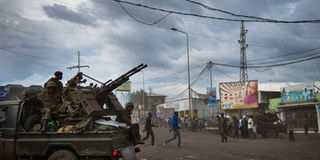A timeline of the fighting in the DR Congo

Congolese government soldiers sit at the back of a pick-up truck mounted with an anti-aircraft gun in the city of Goma, in eastern Democratic Republic of the Congo, on November 18, 2012. Government soldiers were fleeing the eastern DR Congo city of Goma in large numbers today as rebels advanced to the gates of the regional capital after fresh fighting erupted in the area last week, a UN source said. AFP PHOTO/PHIL MOORE.
A timeline of the latest fighting in the east of the Democratic Republic of Congo, where rebels on Tuesday entered the key city of Goma:
- April 29, 2012: Soldiers from the Tutsi ethnic group, who have been integrated into the national armed forces after taking part in early anti-government rebellions, stage a mutiny in the east.
The mutineers include a dozen senior officers close to Bosco Ntaganda, also known as the "Terminator", who is sought for alleged war crimes by the International Criminal Court.
- May 8: The mutineers set up a new rebel movement called M23, named after a peace deal that was signed on March 23, 2009 but later fell apart. The new group is led by Colonel Sultani Makenga, a top leader of the former Tutsi rebel organisation.
- June 4: Human Rights Watch accuses soldiers from neighbouring Rwanda, where Tutsis hold top posts in the government, of supporting the M23 mutiny.
- July 6: Bunagana, on the border with Uganda, falls to M23 after two days of fighting, according to mutineers and police. About 600 DR Congo troops flee into Uganda, according to the Ugandan army.
An Indian peacekeeper with the UN Mission in DR Congo (MONUSCO) is killed in the fighting.
- August 31: Rwanda announces it is pulling out 280 of its soldiers from the eastern DR Congo, where they had been working with government troops fighting rebel militia there, following clashes between the troops and the M23 rebels.
- October 19: The UN Security Council says it intends to sanction leaders of the M23 rebels, and implicitly threatens Rwanda and Uganda, accused of arming the movement.
- November 13: Both the United Nations and United States order sanctions against Makenga, whose rebel forces been accused of killing and raping civilians as they try to carve out a mini-state in east of the country.
- November 15: Fighting breaks out between the army and the M23 near Goma, with both sides accusing each other of having fuelled hostilities. Goma, the biggest city in the mineral-rich region which lies on the border with Rwanda and Uganda, is the capital of North Kivu province.
- November 16: The regional government says 150 M23 rebels have died in fighting with government troops, but the M23 denies this and says its forces have killed nine government soldiers. Congolese officials say the rebels killed were wearing Rwandan military uniforms.
- November 17: A spokesman for the UN peacekeeping forces in the region says the M23 rebels have taken the town of Kibumba, just 25 kilometres (15 miles) from Goma. The UN forces deploy attack helicopters against the rebels.
- November 18: UN Secretary-General Ban Ki-moon says the world body's forces will stay in Goma, after the rebels say they are closing in on the city.
- November 19: The rebels issue an ultimatum to the government, warning that they will continue to fight unless the government opens talks within 24 hours. Kinshasa rejects their demands.
- November 20: Rebel fighters move into Goma. The city's population, of 300,000 in normal times, is swollen by tens of thousands of refugees from fighting elsewhere in the region.




